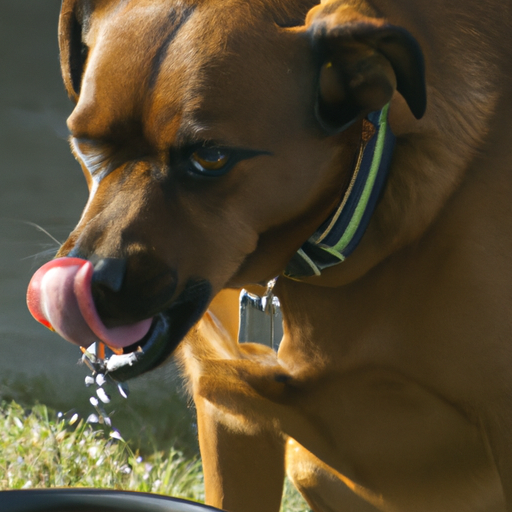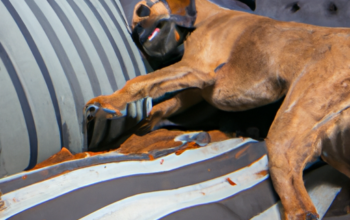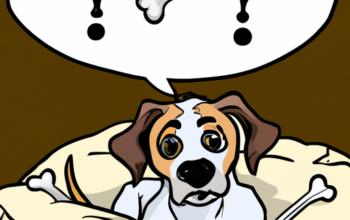Imagine a parched dog lapping up water from a bowl, its tongue moving like a fast-paced pendulum.
You’ve probably witnessed this scene numerous times, but have you ever stopped to wonder how dogs drink water?
In this article, we’ll delve into the fascinating mechanics behind your furry friend’s hydration process.
We’ll explore the unique anatomy of a dog’s tongue that aids in drinking and investigate the role gravity plays in canine hydration.
You’ll learn about the physics involved in lapping and understand how various biological factors affect your pet’s hydration needs.
By understanding these intricate processes, you’ll gain deeper insights into your pet’s health and wellbeing.
So sit tight as we unravel the science behind something as commonplace yet complex as a dog quenching its thirst.
The Anatomy of a Dog’s Tongue
You’ve probably watched your dog lap up water countless times, but have you ever stopped to consider the unique design of their tongue that makes it all possible?
The canine tongue is a fascinating and complex structure. Its surface contains bumps, or papillae, giving dogs their distinctive tongue texture variations. These are not only for providing grip when lapping up water, they’re also home to canine taste buds. Dogs have far fewer taste buds than humans – about 1,700 compared to our 9,000 – yet they still can distinguish between sweet, salty, sour, and bitter tastes.
The underside of a dog’s tongue is smooth and acts as a scoop when drinking. So next time you see your pooch quenching their thirst, remember the incredible anatomy at work!
The Role of Gravity in Canine Hydration
When it’s time for your pup to quench its thirst, gravity plays an essential role by pulling the liquid upwards into their mouth – quite like a furry, four-legged version of sipping from a straw.
This process is simple yet fascinating. You see, dogs lap at water with their tongues curled backward, creating a mini ladle. When they lift their tongue rapidly away from the water surface, this motion pulls up the liquid by overcoming earth’s gravity.
Gravity’s influence on canine hydration is paramount and essentially makes this lapping mechanism possible. However, space hydration where gravity is almost nonexistent poses challenges for our astronaut dogs as conventional drinking techniques simply won’t work without Earth’s gravitational pull.
The science behind how dogs drink water then becomes more complex when considering off-planet scenarios!
The Physics Behind Lapping
It’s not rocket science to understand the physics behind lapping, yet there’s more than meets the eye in this seemingly simple process. When your dog laps water, it’s a blend of fluid dynamics and surface tension at work.
Your dog first thrusts its tongue into the water bowl, which creates an upward column of water due to fluid dynamics. The tip of their tongue curls back towards their lower jaw rather than scooping up like a ladle as you might expect. This movement propels the liquid upward.
Now, surface tension comes into play. Water molecules naturally cling together due to cohesion forces, creating a ‘bridge’ that enables your dog to draw up more water before they finally snap their jaws shut trapping a mouthful of hydration.
Science is everywhere—even in your pet’s drinking habits!
Biological Factors Affecting Hydration
Keeping your pet properly hydrated involves understanding the various biological factors that come into play. It’s not just about how much water they drink, but also their body size, activity level, diet, and health status.
-
Body Size: Larger dogs require more water than smaller ones.
-
Activity Level: Active dogs need more hydration to replace fluids lost through sweating and panting.
-
Diet: Dogs on dry food diets may need extra water compared to those on wet food diets.
-
Health Status: Some diseases like kidney disease or diabetes can increase a dog’s water requirement.
Be aware of canine dehydration symptoms such as excessive panting, dry nose and gums, loss of appetite, and decreased energy levels. Remember that prevention of hydration-related diseases is key in maintaining your pup’s health!
Understanding Your Pet’s Hydration Needs
Knowing your furry friend’s hydration needs can be a game changer in ensuring their overall well-being. The importance of water quality shouldn’t be overlooked. Clean, fresh water is crucial for optimum pet health, aiding in digestion and nutrient absorption, while also regulating body temperature.
Observe for hydration indicators such as skin elasticity and moisture levels in the eyes and mouth. If your dog’s skin doesn’t spring back quickly when gently pinched or if their eyes look sunken or dry, they could be dehydrated.
Ensure you know how much water your dog should drink daily; generally, they need an ounce of fluid per pound of body weight. But remember that factors like age, size, diet, and activity level can influence this. Understanding these nuances helps you cater to your pet’s unique hydration requirements.
Frequently Asked Questions
What are some signs that my dog is not drinking enough water?
If your dog shows dehydration symptoms like dry gums, sunken eyes, and increased lethargy, they’re likely not drinking enough water. Other signs include decreased skin elasticity and excessive panting. Always consult a vet if unsure.
How much water should my dog drink in a day?
Your dog’s hydration schedule is crucial. Typically, they should drink an ounce of water per pound of body weight daily. However, factors like activity level and water quality effects can alter this requirement.
Can certain dog breeds have difficulty drinking water?
Yes, some breeds face hydration challenges. For instance, brachycephalic dogs like Bulldogs may struggle due to their short noses. Water bowl types also matter; shallow bowls can ease their difficulty in drinking water.
Is it safe for dogs to drink water from sources like ponds or puddles?
While it’s crucial for dehydration prevention that your dog stays hydrated, avoid letting them drink from ponds or puddles. These sources can contain waterborne diseases making them unsafe for your pet’s consumption.
Can changes in my dog’s drinking habits indicate health issues?
Yes, changes in your dog’s drinking habits can indicate health issues. Increased water consumption may signal dehydration symptoms, while decreased intake might point to water quality effects making the dog hesitant to drink.
Conclusion
So, you’ve discovered that your dog’s lapping up water isn’t as simple as it seems. Their unique tongue structure and clever use of gravity make each sip a mini engineering marvel.
Biological factors also influence their hydration needs. Now that you understand the science behind it, you’ll appreciate those noisy drinking sessions even more! Remember, ensuring your pet stays hydrated is crucial for their health.



